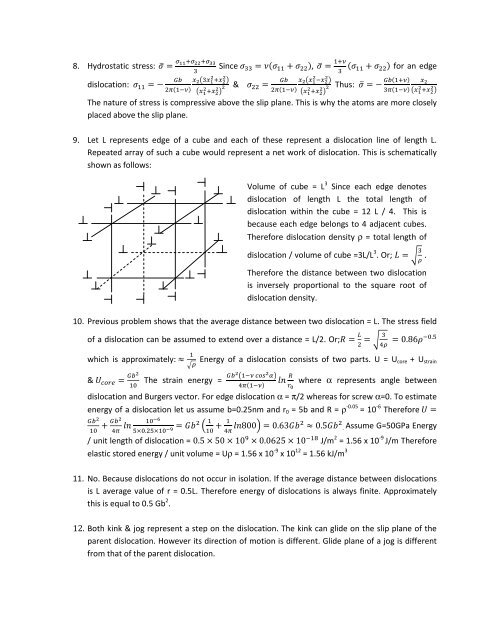Question & Answer Set-5 - nptel
Question & Answer Set-5 - nptel
Question & Answer Set-5 - nptel
Create successful ePaper yourself
Turn your PDF publications into a flip-book with our unique Google optimized e-Paper software.
8. Hydrostatic stress: <br />
Since <br />
<br />
, <br />
for an edge<br />
dislocation: <br />
<br />
<br />
<br />
& <br />
<br />
<br />
<br />
<br />
Thus: <br />
The nature of stress is compressive above the slip plane. This is why the atoms are more closely<br />
placed above the slip plane.<br />
9. Let L represents edge of a cube and each of these represent a dislocation line of length L.<br />
Repeated array of such a cube would represent a net work of dislocation. This is schematically<br />
shown as follows:<br />
10. Previous problem shows that the average distance between two dislocation = L. The stress field<br />
of a dislocation can be assumed to extend over a distance = L/2. Or; <br />
which is approximately: <br />
& <br />
<br />
<br />
<br />
0.86.<br />
Energy of a dislocation consists of two parts. U = Ucore + Ustrain<br />
The strain energy = <br />
<br />
<br />
where α represents angle between<br />
dislocation and Burgers vector. For edge dislocation α = π/2 whereas for screw α=0. To estimate<br />
energy of a dislocation let us assume b=0.25nm and r0 = 5b and R = ρ -0.05 = 10 -6 Therefore <br />
<br />
<br />
<br />
<br />
. <br />
<br />
Volume of cube = L 3 Since each edge denotes<br />
dislocation of length L the total length of<br />
dislocation within the cube = 12 L / 4. This is<br />
because each edge belongs to 4 adjacent cubes.<br />
Therefore dislocation density ρ = total length of<br />
dislocation / volume of cube =3L/L 3 . Or; <br />
.<br />
Therefore the distance between two dislocation<br />
is inversely proportional to the square root of<br />
dislocation density.<br />
<br />
800 0.63 0.5 . Assume G=50GPa Energy<br />
/ unit length of dislocation = 0.5 50 10 0.0625 10 J/m 2 = 1.56 x 10 -9 J/m Therefore<br />
elastic stored energy / unit volume = Uρ = 1.56 x 10 -9 x 10 12 = 1.56 kJ/m 3<br />
11. No. Because dislocations do not occur in isolation. If the average distance between dislocations<br />
is L average value of r = 0.5L. Therefore energy of dislocations is always finite. Approximately<br />
this is equal to 0.5 Gb 2 .<br />
12. Both kink & jog represent a step on the dislocation. The kink can glide on the slip plane of the<br />
parent dislocation. However its direction of motion is different. Glide plane of a jog is different<br />
from that of the parent dislocation.

















